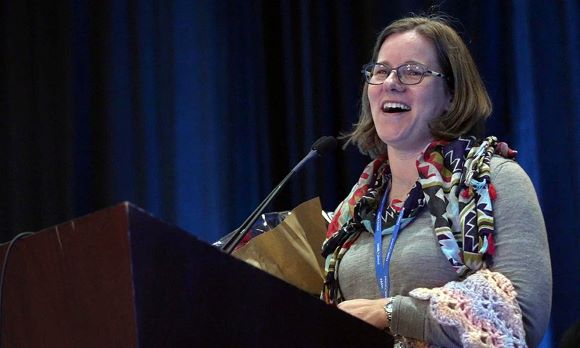Dear School of Arts & Science community,
Part of this academic year has been dedicated to building out a team in the School of Arts & Sciences, and I’m pleased to announce the addition of two critical new members.
Hannah Kallet starts May 6 as a space planning specialist. She will be responsible for helping manage and plan construction projects in the school, and will report to Nicholas Ernst-Maynard, the director of space for both the School of Arts & Sciences and the Hajim School of Engineering & Applied Sciences.
Hannah has many years of experience in design and construction, with much of her work focusing on space planning and project management. Recently, she led a renovation that modernized administrative buildings at Texas Tech University.
A week later, Jen Bathe will join the Dean’s Office on May 13 as my executive administrative assistant. Jen has been with the University since 1999 and comes to us from University of Rochester Medicine Primary Care at West Ridge, where she managed a secretarial and clinical staff for the last four years.
Jen’s help will be key to keeping the office in working order, organizing my calendar and our events and meetings.
Please join me in welcoming Hannah and Jen when they start!
Your Dean,
Nicole
________________________________________________
SAS In Focus is the only newsletter devoted to reporting what’s happening in the School of Arts & Sciences. In this edition . . .
- How the Department of Biology’s Elio Abbondanzieri is enhancing the University’s High Content Imaging Core facility.
- Physics and astronomy professor Adam Frank turns the tables on the scientific worldview in his new book, “The Blind Spot.”
- The Department of Philosophy and the Goergen Institute for Data Science team up to talk AI.
- And more . . .
________________________________________________
RESEARCH GRANTS

The University’s High Content Imaging Core facility will be getting an equipment upgrade in the form of a Zeiss LSM 9890 with Airyscan2, an instrument that combines super-resolution, fast scanning, and high signal-to-noise imaging modes that will greatly expand the facility’s imaging capabilities.
The upgrade comes courtesy of a $627,000 grant through the National Institutes of Health S10 Instrumentation Program, which supports purchases of state-of-the-art commercially-available instruments to enhance research of NIH-funded investigators.
The grant was secured by Elio Abbondanzieri, a research assistant professor in the Department of Biology. Abbondanzieri reports that scientists eager to use the instrument span a diverse set of research interests covering cutting-edge areas of quantitative biology.
________________________________________________
BOOK NOOK

In “The Blind Spot,” physics and astronomy professor Adam Frank and his co-authors turn the tables on the scientific worldview by arguing that experiencing the world precedes being able to practice science. “We must live the world before we conceptualize it,” the authors write, in order to give science its “proper footing.”
In a review published in Los Angeles Review of Books, Stony Brook University philosophy professor Robert P. Crease writes that the book offers “sparklingly clear accounts of seemingly forbidding concepts” that scientists and nonscientists alike can appreciate. “The discussion is so clear, well paced, and witty,” he writes, “that I’d be tempted to describe it as a breezy read if that didn’t risk coming across as a slight.”
In other news . . .
A launch party celebrating the publication of “Prior Art: Patents and the Nature of Invention in Architecture,” a new book by Peter Christensen, Arthur Satz Professor of the Humanities, is planned for May 6.
The gathering will take place from 5-6 p.m. in the Humanities Center Conference Room D and feature a conversation between Christensen, a professor of art and art history, and Christopher Heuer, professor of art history.
The book, published by The MIT Press, has been described as a groundbreaking text on the history of the use of patents in architecture.
Christensen, who is also the Ani and Mark Gabrellian Director of the Humanities Center, researched the subject as a Guggenheim Fellow. Read more about the background of his project.
________________________________________________
FACULTY AWARDS

Christie Petrenko, a research associate professor at the University’s Mt. Hope Family Center, director of clinical training in the Department of Psychology, and an associate professor of pediatrics, has been recognized with the 2024 Starfish Award, presented at FASD United’s 9th International Research Conference on Adolescents and Adults with Fetal Alcohol Spectrum Disorders. The award, whose recipients are selected by a committee of adult self-advocates with FASD, recognizes Petrenko’s considerable contributions as a researcher and an advocate in the field.
Petrenko is the codeveloper of an FASD mobile app. She has coauthored a training manual to help medical professionals diagnose the disorder as well as a comprehensive FASD resource for clinicians and researchers.
Read about Petrenko’s work to help people with FASD thrive.
________________________________________________
TALKS & LECTURES

May 3: “Evaluating AI Capabilities as Affordances,” 3-5 p.m., Dewey Hall, Room 2110-D
The Department of Philosophy and the Goergen Institute for Data Science teamed up to sponsor this talk by Sina Fazelpour, an assistant professor of philosophy and computer science at Northeastern University. In his talk, Fazelpour looks to offer a more functionally and ethically robust approach to evaluating artificial intelligence tools. The colloquium is part of an ongoing series related to philosophers working on AI ethics.
May 9: “What Species is Multispecies Justice?” 5 p.m., Humanities Center Conference Room D, Rush Rhees Library
Cary Wolfe, an English processor at Rice University and leading scholar of posthumanism, opens the Humanities Center’s “Badgering Architecture” symposium with a public keynote address on multispecies justice. His talk considers two of the most prominent political models of justice for other species — “animal rights” and “rights of nature”— and traces their implications for the nexus of life, law, and ethics.
May 13: “Materials Discovery at Extreme Pressures,” 4-5 p.m., Hutchinson Hall, Room 140
The ability to study matter under extreme pressures and temperatures has chemists asking, “Under want conditions do elemental systems for stable phases?” and “Can these new phases be recovered for further study and integration into technology?” In this seminar sponsored by the Department of Chemistry, chemist James Walsh, of the University of Massachusetts Amherst, describes some of the novel methods used in his lab that empower scientists with the tools they need to precisely target and recover high-pressure phases.
________________________________________________
GOT NEWS TO SHARE?
Send your SAS In Focus news tips to SAS Senior Communications Officer David Andreatta at david.andreatta@rochester.edu. Be sure to put “SAS In Focus” in the subject heading, and tell him about research, awards, publications, and symposiums, and whatever other news you think is fit to print.